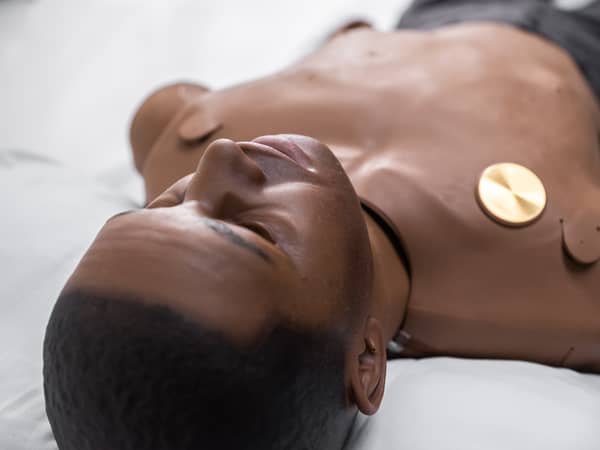
2024
In 2024, Laerdal developed SimMan Critical Care. Designed for in situ simulation, SimMan Critical Care provides advanced training in respiratory care, critical care, and anesthesia practice using onboard technology to deliver tetherless mechanical ventilation, enabling learners to progress through transitions of care from pre-hospital to ICU. Learners can engage in hands-on learning experiences practicing basic to advanced medical techniques for a cutting-edge training experience, aligning healthcare education with the demands of the evolving medical landscape.
2021
Among other things, the Covid-19 pandemic has renewed the focus on reducing health disparities.
In order to improve care quality and help learners develop the necessary skills to treat diverse patient populations, Laerdal has released SimMan 3G PLUS. This modular and sustainable solution offers interchangeable face skins and a range of skin tones to reflect the diversity of real patients – while using just one simulator.
2018
A large benefit that simulation offers is giving learners the opportunity to rehearse real-world, specialised training – something that might otherwise be hard to practice. Recognising the need for multidisciplinary team training for Endovascular Specialists, Cath Lab teams, and Pre-hospital care providers, Laerdal developed SimMan Vascular. Built on Laerdal’s SimMan 3G platform with Mentice’s VIST endovascular simulation technology inside, SimMan Vascular is an integrated emergency patient and endovascular procedure simulator.
2016
In 2016, Laerdal developed SimMan ALS, a mobile and durable solution to meet the needs of pre- and in-hospital emergency care providers. SimMan ALS can be used in conjunction with the Laerdal-SonoSim Ultrasound Solution, LiveShock, or ShockLink to meet a client’s specific training requirements.
2015
In 2016, a Johns Hopkins study calculated that more than 250,000 deaths each year in the U.S. are due to medical error.2 These findings were groundbreaking as the death toll made medical errors the third leading cause of death after heart disease and cancer.3 The year prior, the National Council of State Boards of Nursing (NCSBN) published a study demonstrating that simulation can successfully substitute up to 50% of traditional clinical hours across the prelicensure nursing curriculum.4
Following these two studies, it became clear that organizations and the healthcare professionals within them were making moves to reverse the problem. Also, at this point, the general public began gaining awareness of the issues that might affect them and their health.
2014
In 2014, Laerdal released SimMan 3G Trauma. It was developed with severe trauma training needs in mind – particularly those of the military and the pre-hospital setting. SimMan 3G Trauma provides clients with the ability to simulate amputated limbs, sternal intraosseous infusion (IO) access, and bleeding control. These features, among many others, help to shape a realistic trauma emergency scenario for learners.
2013
As patient safety initiatives were gaining traction in hospitals, the military also worked to improve the scope and realism of their training. In 2013, Laerdal introduced SimMan 3G Mystic – a simulator designed specifically for the U.S. Army. SimMan 3G Mystic is designed specifically to meet the needs of training for Tactical Combat Casualty Care (TCCC). SimMan 3G Mystic is only available to U.S. clients. Laerdal takes pride in knowing that we are enabling our military lifesavers to train to the best standards possible.
2012
In 2012, the Leapfrog Group introduced the Hospital Safety Score, the first letter grades assigned to over 2,500 hospitals rating how safe their care practices were.5 During the same year, the Centers for Medicare and Medicaid Services (CMS) launched the Accountable Care Organizations (ACO) Model. It sought to spend health care dollars more wisely while enforcing the delivery of quality care among its providers.6
These two movements for patient safety signified that the public and the government had a greater demand for transparency. They also held healthcare professionals and the organizations within which they work more accountable for medical errors made.
2010
In 2010, Laerdal introduced SimMan Essential. SimMan Essential offers comprehensive clinical functionality to teach core skills in airway, breathing, cardiac, and circulation management. By offering an expanded simulator portfolio, Laerdal gave clients the power to choose a solution tailored to their needs. It was not long before SimMan Essential was seen as a common element in training within EMS, the Military, and Hospital Emergency Rooms.
2009
After realising the need for high-fidelity physiological responses in a simulator that could be used in an in situ setting – i.e. a real clinical environment – Laerdal developed SimMan 3G . This member of the SimMan family can display neurological symptoms as well as physiological symptoms and can easily be made mobile with wireless technology. SimMan 3G provides educators with the flexibility to train basic and advanced skills in a team-based setting.
2004 - 2007
The Human Factor (2004) shed light on the importance of teamwork and communication.7 Recommendations to reduce error included the use of the SBAR (situation, background, assessment, recommendation) tool and closed-loop communication tactics.
In 2006, the Agency for Healthcare Research and Quality (AHRQ) released Team Strategies and Tools to Enhance Performance and Patient Safety (TeamSTEPPS). These insights were designed to serve as the national standard for team training in healthcare.8 Shortly after, in 2007, the Quality and Safety Education for Nurses (QSEN) Institute created the QSEN Competencies. The competencies can be applied in a multitude of settings to develop nurses with the knowledge, skills, and attitudes necessary to continuously improve the quality of healthcare.9
Each of these initiatives made evident the fact that the healthcare community had begun to respond to threats on patient safety.
2001
In 2001, the Institute of Medicine (IOM) published the groundbreaking "Crossing the Quality Chasm: A New Health System for the 21st Century.” In response to the estimated 98,000 deaths occurring annually in U.S. Hospitals due to medical error, the IOM defined six aims for delivering quality care. The IOM states that healthcare should be: safe, effective, patient-centered, timely, efficient, and equitable.10 The IOM put the issue of patient safety front and center before healthcare policymakers, setting plans in motion.

